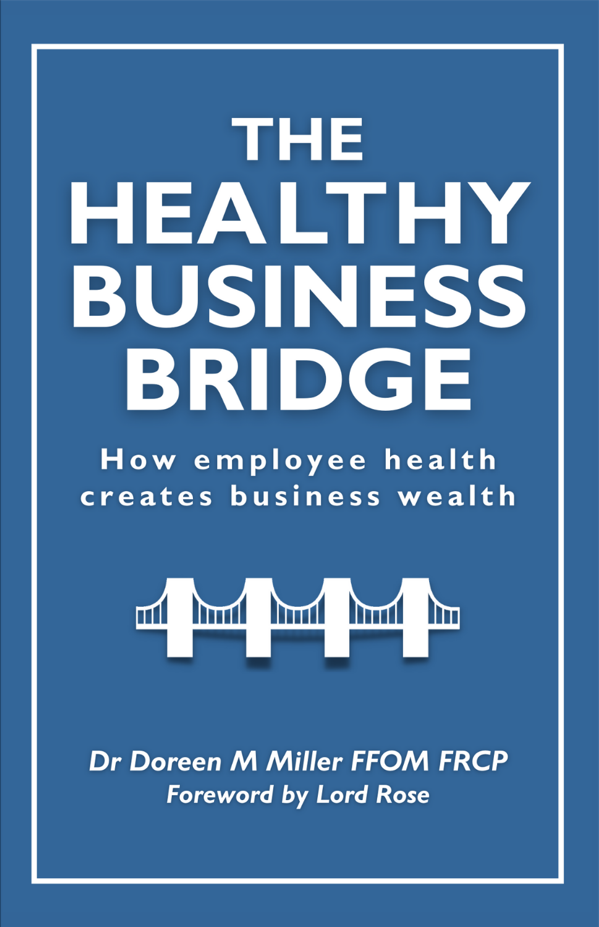There are many books written for organisation leaders, HR and line management teams that focus on building healthy workplaces, from a range of different perspectives. This clearly shows that the answers to the questions of how to reduce absenteeism, address low engagement and underperformance and so address the financial impacts these have on the bottom line, are still elusive.
This book does go some way to addressing these, by considering how to maintain a healthy workplace through the lens of occupational health in a business context. The author introduces her R-O-P-E SystemTM, designed to uncover and address employee health symptoms. Packed with case studies and examples, Miller explains and illustrates how business and HR leaders can help to spot problems and take action.
The underpinning concept of The Healthy Business Bridge is that you need to know where you are both in terms of your business performance and employee health (or ill-health). The Bridge (with four pillars – the R-O-P-E SystemTM) are the areas that can affect employee health – and so the health of your business. By working through the book and spotting – and taking steps to address – the unhealthy parts of your business using the R-O-P-E SystemTM, you can then move forward and cross the bridge.
After setting the scene for the reader by explaining occupational health in the context of today’s business environment, Miller then takes us through each of the four pillars of the R-O-P-E SystemTM – Roles – Organisation – People – the work Environment. This system uses the analogy of a four-pillar bridge which “carries your business from where it is now to where you want it to be…. if any of the pillars become damaged, so is the health not only of your employees but your business too.”
In each chapter of part 2 of the book, Miller explores each of the four pillars of the R-O-P-E SystemTM in more detail. This helps the reader spot and engage with the problems relevant to them and identify the root cause, enabling them to take action.
Each of these sections is supported by case study stories illustrating the approach in practice and concludes with a set of reflective questions, helping to prompt and shape thinking appropriate to the reader’s own business. As an example, when considering the Roles – the R of R-O-P-E, the chapter explores aspects like role definition, pressure in roles, hours of work, travel in the role and good work (including work environments and social relationships).
After considering each of the four pillars in detail, giving the reader a baseline of where they might be in terms of root cause, in Part 3 of the book, Miller walks the reader through an approach to move from ‘where you are now to where you want to be’. The final three chapters in this section focus on very tangible ways that leaders can move forward and includes an exploration of health risk management, policies and insurance benefits, as well as looking at employee wellbeing.
For me, one of the most useful chapters in the book is the final one. Miller applies the R-O-P-E SystemTM to the arrival of Covid-19 and managing the related health risks – it’s a perfect case study that every business leader should be able to relate to. She explores each of the R-O-P-E pillars in the context of Covid-19, supported by reflective questions, signposts the thinking for the reader to move to where they want to be and wraps up with a focus on employee wellbeing.
This book is different to ones I’ve read previously on the topic of employee health and wellbeing. By addressing these as business challenges through the lens of occupational health and focusing on finding the root cause before moving forward by using the R-O-P-E System, it’s firmly grounded in helping organisations support their people and so help them achieve their business goals.
Miller’s R-O-P-E SystemTM is a valuable tool for leaders – and I’d suggest especially those in HR and line management roles – to use at any point. As an example, it could be a good approach to follow when tackling the challenges related to returning to workplaces and introducing hybrid working
In our world of rapid change, where leaders have to flex quickly and bring their teams with them just as quickly, Miller’s approach is a timely reminder that:
“The good health of a business depends on the good health and productivity of its employees. Without people, there is no business.”
Available here
Jo Twiselton, Change leadership coach & consultant, founder of Twist Consultants







